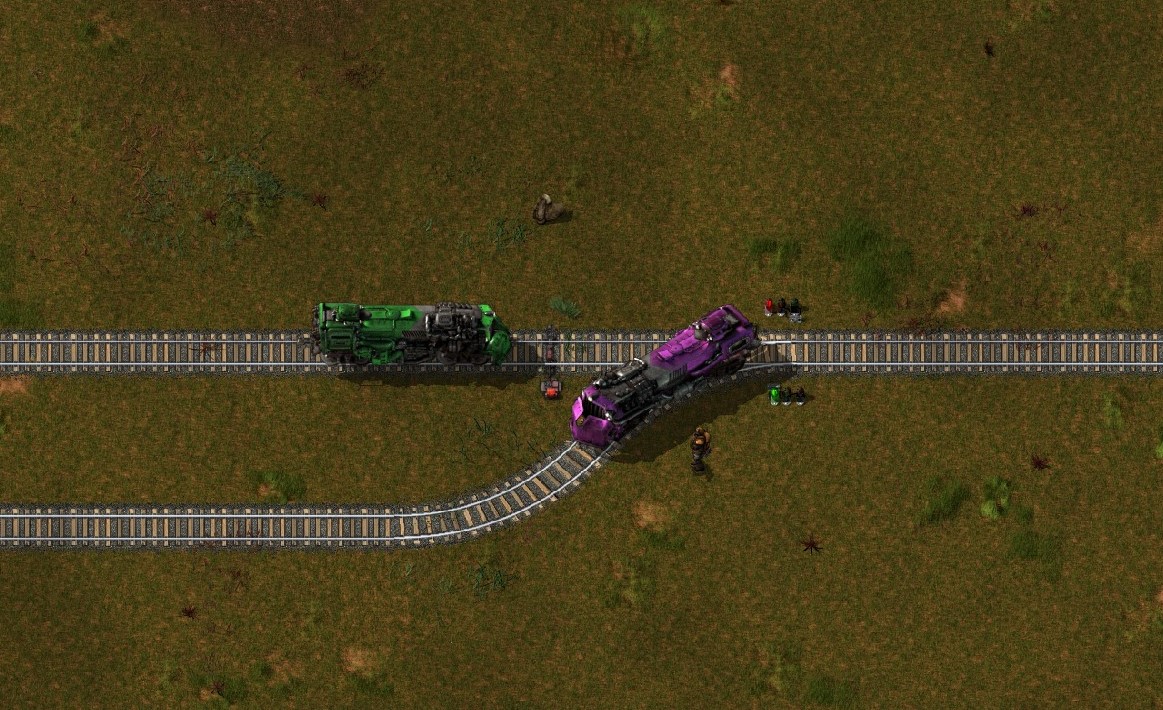Do train signals compare themselves to oncoming signals?
Posted: Sat Mar 11, 2017 6:07 pm
I've spent all morning figuring out train signals, and so far they seem pretty reasonable:
- normal signals effectively mean "is there a train in front of me?" or "is the track in front of me safe to drive onto?"
- chain signals just copy the signal in front of them
The part that I'm confused by, and maybe I'm mis-using the signals, is that they seem to also look at oncoming signals, instead of just the ones travelling the same direction. i.e. If I have a chain signal, it will copy the red-value from oncoming signals, and not just the ones in front of them that are also travelling the same direction. For normal signals, this means that the section of track that they look at for safety/emptiness, stops at oncoming signals, instead of the next signal travelling the same direction. This means that I can't do a seemingly simple thing (which other people have done, but failed to post simplified screenshots of...), which is to have a two-way section of track, with one-way sections for trains to pass each other.
This screenshot shows this problem - there's two sections of one-way passing track, and a section of two-way dangerous track, which I've marked with signals. The problem is that some of the signals stop early. For example, the chain signal in front of the green train should (in my understanding) be green, since the normal signal in front of it is also green - but it's instead copying the red signal from the signal that's pointing the other direction! This second screenshot shows a normal signal (one-way only) that's only looking as far ahead as the oncoming signal, and my understanding is that that would never be useful, since I wouldn't be able to have single-direction tracks (passing tracks / side-tracks) connected to bi-directional tracks. i.e. I either get to make my entire network single-direction, or my entire network must be bi-directional.
Could somebody help me understand how the signals are intended to be used? I am clearly using them wrong, because what's intuitive doesn't seem to be what's in the game.
P.S.
Sorry if this is explained somewhere else; I couldn't find anything on the wiki, or by searching these forums, that answered this specific question. (In fact, the info I've managed to find is either the trivial bullet points I wrote above, or subjects more advanced than this particular situation.)
P.P.S.
I can use double-wide, single-direction tracks, because I read through and uderstand this guide with simple rules of thumb. I would however, like to know how to use bi-directional tracks, so I can cut my rail usage by nearly half.
- normal signals effectively mean "is there a train in front of me?" or "is the track in front of me safe to drive onto?"
- chain signals just copy the signal in front of them
The part that I'm confused by, and maybe I'm mis-using the signals, is that they seem to also look at oncoming signals, instead of just the ones travelling the same direction. i.e. If I have a chain signal, it will copy the red-value from oncoming signals, and not just the ones in front of them that are also travelling the same direction. For normal signals, this means that the section of track that they look at for safety/emptiness, stops at oncoming signals, instead of the next signal travelling the same direction. This means that I can't do a seemingly simple thing (which other people have done, but failed to post simplified screenshots of...), which is to have a two-way section of track, with one-way sections for trains to pass each other.
This screenshot shows this problem - there's two sections of one-way passing track, and a section of two-way dangerous track, which I've marked with signals. The problem is that some of the signals stop early. For example, the chain signal in front of the green train should (in my understanding) be green, since the normal signal in front of it is also green - but it's instead copying the red signal from the signal that's pointing the other direction! This second screenshot shows a normal signal (one-way only) that's only looking as far ahead as the oncoming signal, and my understanding is that that would never be useful, since I wouldn't be able to have single-direction tracks (passing tracks / side-tracks) connected to bi-directional tracks. i.e. I either get to make my entire network single-direction, or my entire network must be bi-directional.
Could somebody help me understand how the signals are intended to be used? I am clearly using them wrong, because what's intuitive doesn't seem to be what's in the game.
P.S.
Sorry if this is explained somewhere else; I couldn't find anything on the wiki, or by searching these forums, that answered this specific question. (In fact, the info I've managed to find is either the trivial bullet points I wrote above, or subjects more advanced than this particular situation.)
P.P.S.
I can use double-wide, single-direction tracks, because I read through and uderstand this guide with simple rules of thumb. I would however, like to know how to use bi-directional tracks, so I can cut my rail usage by nearly half.
